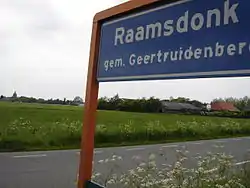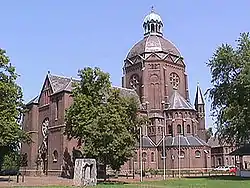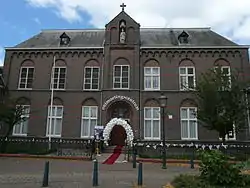Raamsdonk
Raamsdonk is a village in the province of North Brabant, Netherlands. It is located in the municipality of Geertruidenberg, about 15 km northeast of Breda.
Raamsdonk | |
|---|---|
Village | |
 Entrance Wielstraat, view Raamsdonk-Dorp and Church of Saint-Bavo | |
| Coordinates: 51°41′16″N 4°54′29″E | |
| Country | Netherlands |
| Province | North Brabant |
| Municipality | Geertruidenberg |
| Area | |
| • Total | 12.98 km2 (5.01 sq mi) |
| Population (2007) | 2,190 |


Toponymy
Raamsdonk (as "Dunc") is mentioned for the first time in 1253 as Ramesdunc and 1330 as Raemsdonc. A "dunc" or "dark" is a sand hill in a marshy area. The " Raams " prefix may indicate the presence of a certain type of plant, the wild garlic. However, it may also be the name of a person.
History
In 1609, the St. Lambert church became part of the Reformed Church. In 1611, the first pastor came.
The Catholic people were allowed, in 1690, to establish a church in a barn. In the hamlet Waspikse the Benedenkerk. In 1787, another church in a barn was installed in Raamsdonk. This church was dedicated to Saint-Bavo and was in Bergenstraat. In 1798, however, Catholics demanded to return to the St. Lambert church. They did not succeed but received a sum of money in compensation. The barn church served the community until 1888. Then a new monumental St. Bavo Church, was built according to the plans of the architect Carl Weber. It is located in the present village.
At Raamsdonk until about 1850 existed a small French community,[1] with among them a Graveline family, as well as Rotterdam around 1700 and Philippine in Zealand.
Raamsdonk was a separate municipality until 1997, when it became part of Geertruidenberg.[2]
References
- Ad van der Meer and Onno Boonstra, Repertorium van Nederlandse gemeenten, KNAW, 2011.
External links
- J. Kuyper, Gemeente Atlas van Nederland, 1865-1870, "Raamsdonk". Map of the former municipality, around 1868.